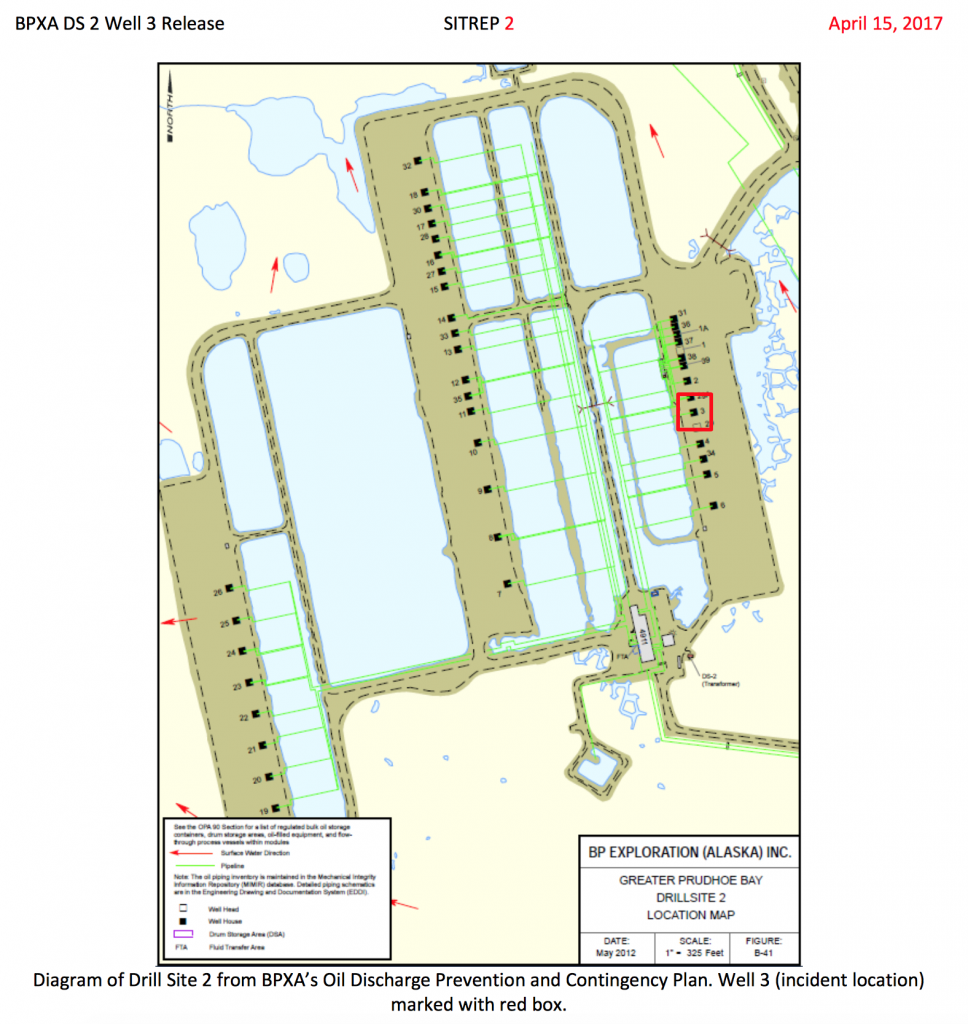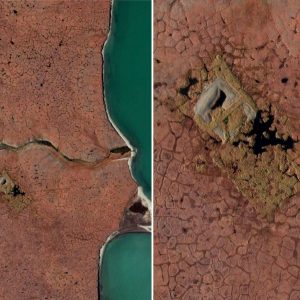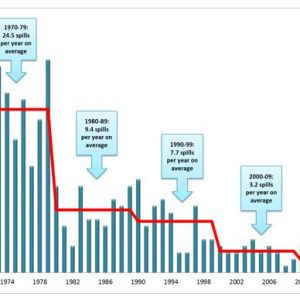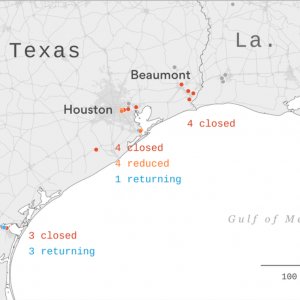
EPA’s initial stages of establishing a unified command on the frozen North Slope of Alaska. Image: EPA, April 15, 2017.
British Petroleum’s (BP) oil and gas well on Alaska’s Northern Slope (formally the BPXA Flow Station 1 Drill Site 2 Well 3 Release) that blew out on Friday continues to spill petroleum. The remoteness of the site translates into essentially all the info coming from BP (or via state authorities who are in turn passing along BP’s information releases). As of Sunday, BP was reporting there have been no injuries or conspicuous damage to wildlife. Crews trying to secure the well have failed amid freezing winds gusting to 61 kph (38 mph). As so often happens in these situation where we have little detailed info, largely useless facts (such a windspeed) get amplified throughout the media covering the story and repeated verbatim across numerous news outlets. That is the station with this blowout at the moment.
 Wellhead pressure was monitored throughout the night and appears to have necessitated some bleed off of riding pressure to avoid further damage to the casing. As of Monday morning we have zero estimates as to the amount of natural gas and oil released to date. This is quite curious as the crews must have at least a very vague estimate. Again, the lack of information is concerning and the default situation with most spills of this nature in recent years.
Wellhead pressure was monitored throughout the night and appears to have necessitated some bleed off of riding pressure to avoid further damage to the casing. As of Monday morning we have zero estimates as to the amount of natural gas and oil released to date. This is quite curious as the crews must have at least a very vague estimate. Again, the lack of information is concerning and the default situation with most spills of this nature in recent years.BPXA Flow Station 1 Drill Site 2 Well 3 Release
| Location | BPXA Drill Site 2 (DS2) pad, Well 3 in the Greater Prudhoe Bay area approximately 5 miles from the Deadhorse Airport (Lat/Long: 70.268653, -148.78641). |
|---|---|
| Product/Quantity | The well is currently venting gas, which caused an initial spray of crude oil that impacted the well pad. However it is not currently spraying crude oil. A Forward Looking Infrared (FLIR) overflight shows that the crude spray plume did not leave the pad, however, the situation is not safe yet for responders to access the area and confirm that there have been no impacts to adjacent tundra. No volume estimate for crude spray released is available at this time. |
| Cause | The cause of the release is unknown at this time. ADEC is coordinating with BPXA and the Alaska Oil and Gas Conservation Commission (AOGCC) to investigate the cause of the release. Well 3 is an oil and gas production well. |
| Initiation of Spill | Unknown |
BP has dealt with several spills and leaks in Alaska in the past. In 2006, a corroded pipeline released nearly 5,000 barrels of crude oil, the largest oil spill in the North Slope at the time. Another spill occurred in 2009 that saw just over 1,000 barrels leak.
In 2010, a BP-operated drilling rig called Deepwater Horizon exploded, killing 11 people and spilling nearly 5 million barrels of oil into the Gulf of Mexico, making it the largest oil spill in U.S. federal waters. BP eventually agreed to pay $18.7 billion to settle all federal and state claims related to the spill.
A Forward Looking Infrared or FLIR overflight shows that the crude spray plume did not leave the pad, however, the situation is not safe yet for responders to access the area and confirm that there have been no impacts to adjacent tundra. No volume estimate for crude spray released is available at this time. Two leaks have been identified on the well, one near the top and one further down the well assembly. The top leak was misting oil in conjunction with releasing natural gas, but the activation of the surface safety valve has stopped the release from this point. The bottom leak is currently leaking gas as well as some minor amount of crude oil. The well structure is housed in a metal “well house” which is helping to contain any oil spray.
On Monday, nearly three days after the leak was found, ADEC announced the unified command had to managed to “kill” the well overnight and end the gas leak.
“The area impacted is limited to gravel,” says Candice Bressler, spokesperson for ADEC. “There have been no reports of impacted wildlife.” Oil droplets were found on about 1.5 acres of the well’s drill pad, according to The Associated Press.
The community of Nuiqsut, 50 miles west of the site, had been notified of the incident, but was not evacuated.
“Responders determined that the well had ‘jacked up,’ or risen, approximately 3 – 4 feet; this vertical movement of the well caused the pressure gauge to break off and prevented operations from pumping into the well to kill it,” ADEC reported.
BP began drilling at the massive Prudhoe Bay oil field in 1968. It has generated more than 12 billion barrels of oil, according to BP, and remains one of North America’s largest oil fields.
The leak happened amid efforts to boost output from aging wells and reach new supplies in the North Slope’s oil fields, reports Bloomberg:
“North Slope production rose to 565,000 barrels a day in March, its highest level since December 2013. That’s still down by almost three-quarters from the peak of more than 2 million barrels in the late 1980s.”







Leave a Reply